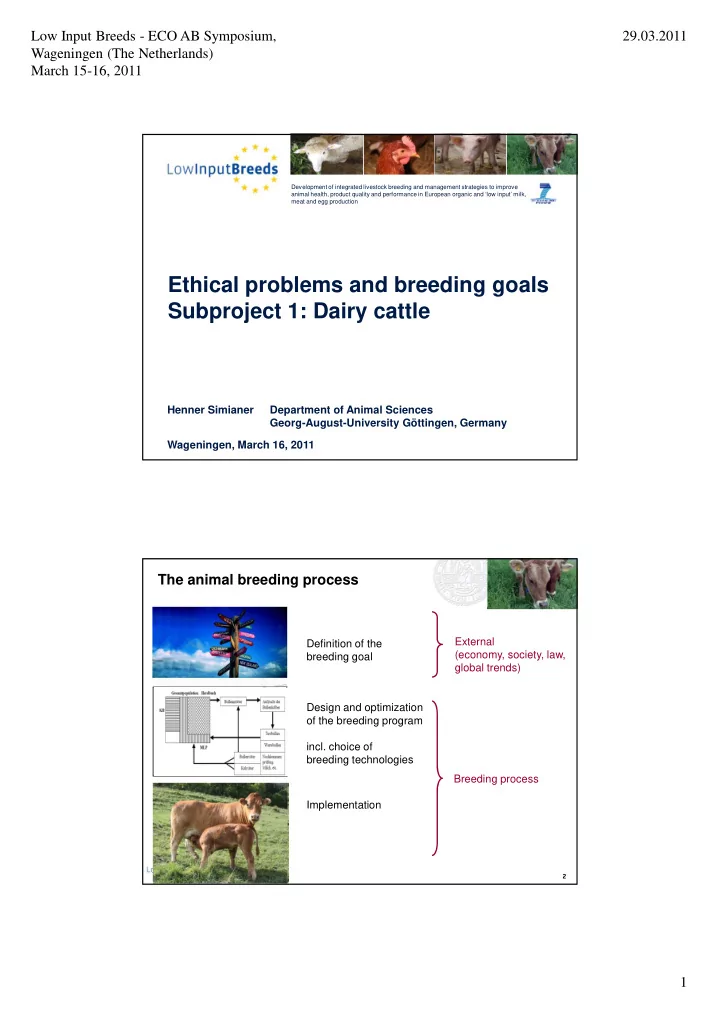

Low Input Breeds - ECO AB Symposium, 29.03.2011 Wageningen (The Netherlands) March 15-16, 2011 Development of integrated livestock breeding and management strategies to improve animal health, product quality and performance in European organic and ‘low input’ milk, meat and egg production Ethical problems and breeding goals Subproject 1: Dairy cattle Henner Simianer Department of Animal Sciences Georg-August-University Göttingen, Germany Wageningen, March 16, 2011 The animal breeding process External Definition of the (economy, society, law, breeding goal global trends) Design and optimization of the breeding program incl. choice of breeding technologies Breeding process Implementation � 1
Low Input Breeds - ECO AB Symposium, 29.03.2011 Wageningen (The Netherlands) March 15-16, 2011 3 usable arable land (kHa) Global Trends Livestock Revolution Population (mio) Projection until 2050: arable land (m 2 ) per capita � Increase of food production ~1% p.a. � Constant ressources � Increase of ressource efficiency � disproportionately high increase of animal production (~ 2 to 3% p.a.) 2
Low Input Breeds - ECO AB Symposium, 29.03.2011 Wageningen (The Netherlands) March 15-16, 2011 > 50 % of increase of productivity through breeding Protein yield (1. Lactation) of Holstein-Friesian-cows 80 protein yield relative to base year 1995 (kg) 70 60 46 % improved phenotypic 50 production technology kg 40 30 genetic 20 54 % genetic progress 10 0 1995 1997 1999 2001 2003 2005 2007 birth year (data source: VIT Jahresbericht 2008) Jahr Breeding goals in Holstein Friesian 2000 USA-TPI Canada-LPI Italy-ILQM USA-NM$ Germany-RZG FRA-ISU DK/SWE NL-DPS New Zealand 0% 10% 20% 30% 40% 50% 60% 70% 80% 90% 100% Performance Type SCS Longevity Fertility Others 2005 Germany 2010 Germany 2005 USA-TPI CAN-LPI FRA-ISU NL-DPS Italy-PFT DK/SWE/FIN New Zealand 0% 10% 20% 30% 40% 50% 60% 70% 80% 90% 100% Performance Type SCS Longevity Fertility Others 3
Low Input Breeds - ECO AB Symposium, 29.03.2011 Wageningen (The Netherlands) March 15-16, 2011 Genomic selection for fuctional traits Production traits vs. functional traits – options for genomic selection 180 Why is this so? 160 � low heritability of functional traits 140 � unfavourable 120 genetic 100 correlations to production traits 80 � difference in 60 quantity and 40 quality of performance test 20 data 0 economic realized genetic GS GS – weight trend functional traits Technologies in dairy cattle breeding � Artificial insemination (> 80% of matings) � Sperm sexing (< 1% of matings) � Embryo transfer (< 1% of cows) � Ovum pick up/in vitro fertilization (< 1% of cows) � 54k SNP chip genotyping (~1000 to 2000 male calves per month in Germany) based on DNA-containing tissue (blood, semen, hair, milk) All technologies socially accepted and in routine use Use of AI: no difference between conventional and ecological dairy breeding (Schmidtko, 2007) 54k genotyping quantitatively ‚exploded‘ within no time 4
Low Input Breeds - ECO AB Symposium, 29.03.2011 Wageningen (The Netherlands) March 15-16, 2011 Relationship under genomic selection Simulation study (Chen et al., 2011): 5 generations of selection on pedigree-based BLUP or on genomic breeding values Accuracy of estimated breeding values Average relationship of top 10% animals 0,7 0,06 0,6 0,05 0,5 0,04 0,4 0,03 0,3 0,02 0,2 0,01 0,1 0,00 0 h2=0.1 h2=0.3 h2=0.5 h2=0.1 h2=0.3 h2=0.5 Relationship under genomic selection Empirical study (Chen, 2011): average relationship of the top 50 out of 816 young Holstein bulls selected based on pedigree-based BLUP or on genomic breeding values for different traits 0,07 0,06 0,05 Relationship 0,04 0,03 0,02 0,01 0 CFI CEP SP FA SCS FL FUA RUH UO RA UD RW FY PY FP PP h 2 = 0.04 h 2 = 0.45 5
Low Input Breeds - ECO AB Symposium, 29.03.2011 Wageningen (The Netherlands) March 15-16, 2011 Conclusions and theses Global trends require an increase of animal production per year by ~ 2 to 3 per cent until 2050 Due to limited ressources (land, water, minerals etc.) the increase has to be ressource-neutral (or ressource-saving), improving ressource efficiency will be most relevant (also, or even especially, true for low input systems) Breeding makes up for > 50 per cent of the progress in productivity With conventional breeding tools, a genetic progress of ~ 1 per cent per year seems to be the limit (under favourable conditions) Genomic breeding approaches have the potential to boost the level of genetic progress towards the necessary rate Potential to genomically select very good young bulls to be used for natural service on farm Conclusions and theses Technologies used in genomic breeding programs (AI, ET, OPU/IVF, SNP-genotyping) are well established and socially accepted Additional genetic progress through genomic selection provides options to over-proportionally improve traits related to fitness, fertility and animal welfare Genomic selection has a ‘built-in’ mechanism to reduce the inbreeding rate (esp. when selecting for functional traits) Both breeding goals and breeding technologies need an ethical assessment Waiving the possibility to increase productivity and/or ressource efficiency by an (‚ethically‘ motivated) non-use of technological options also has an ethical dimension and needs justification 6
Low Input Breeds - ECO AB Symposium, 29.03.2011 Wageningen (The Netherlands) March 15-16, 2011 The authors gratefully acknowledge co-funding from the European Commission, under the Seventh Framework Programme for Research and Technological Development, for the Collaborative Project LowInputBreeds (Grant agreement No 222623) 13 7
Recommend
More recommend